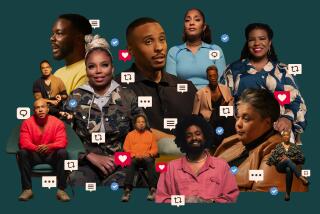Twitter, a tyrant’s nightmare
- Share via
Twenty years ago, the world was transfixed by an image of courageous resistance -- a lone young man standing in the road before a column of Chinese army tanks moving into Tiananmen Square to crush the students and others who’d gone there to demonstrate for reform.
Since Saturday, the global community has been similarly gripped by the tragic photos and video of Neda Agha-Soltan, the 26-year-old Iranian woman shot to death on the streets of Tehran while on her way to one of the protests over that country’s disputed presidential election.
The most famous of the photos of the Chinese hero was taken by Associated Press photographer Jeff Widener. Other memorable images of the standoff were shot by photo journalists who were in Beijing working for Newsweek, Reuters and the Magnum photo agency. In Iran, by contrast, we still don’t know who took the stills, video and audio recordings of the dying young woman, who has become known to tens of millions simply as “Neda,” because the images and sound were collected on the cellphones of her fellow demonstrators and surreptitiously transmitted over the Internet to the rest of the world.
In those differing attributions, we can begin to see the future of foreign news reporting.
Two things of immense consequence have occurred since the 1989 massacre in Tiananmen Square: For economic reasons, far fewer Western journalists are dispatched to cover international crises, like the June 12 Iranian election; at the same time, millions of people around the world -- and particularly in countries with large, well-educated young urban populations, like China and Iran -- have joined the new media revolution. The Internet, social media networks like Twitter and Facebook, and cellphones with the ability to text-message and to record and transmit images have become interwoven with their daily lives.
The Iranian resistance is the first popular movement to present itself to the world, in significant part, through new media. But while it’s true that something new and unexpected is happening here, the process hasn’t gone as either many traditional journalists or the Web’s theoretical triumphalists ever foresaw.
As Mahmoud Ahmadinejad’s government and its thuggish clerical allies have choked off more and more of the Western media’s access to events, thousands of Iranians armed with cellphones and social network connections have taken the reporters’ and photographers’ place. However, instead of the emergence of full-blown “citizen journalists” -- the ideal of Internet enthusiasts -- you’ve seen thousands of ordinary Iranians on the scene feeding information and images to other media, both traditional and nontraditional, much in the manner of volunteer stringers.
Over the last week, a variety of Western bloggers and alternative media outlets -- notably Andrew Sullivan’s blog and Al Gore’s Current TV -- have sorted through and ordered the incredible volume of information. Traditional news organizations -- most notably CNN and the BBC -- have relied on lots of information from ordinary citizens and have been extremely transparent about how they’ve done so, sorting it out right in front of their viewers.
The hard work of verifying, analyzing and fleshing out the facts has been left to the journalists on the scene -- notably New York Times columnist Roger Cohen and this paper’s Borzou Daragahi, whose profile of Neda Agha-Soltan in Tuesday’s Los Angeles Times was a model of what only print journalism can provide.
This hybrid journalism -- developed without plan and under the most intense pressure imaginable -- is the best and most workable glimpse of the West’s informational future we’ve yet seen.
Meanwhile, the mullahs and their buddies can throw out all the correspondents they want, but the facts keep flowing. This is bad news for authoritarian governments. In the future, they’ll have to choose between underdevelopment -- denying their people social media, cellphones and the Internet -- and control. It’s a little clearer now why the Chinese are demanding that all PCs and hand-helds sold in that country come with built-in censorship hardware. Lots of luck with that.
Tyranny’s irreducible dilemma is that the Web is, in its chaotic essence, the product of an open society. You can’t have its benefits without accepting the democratic baggage.
Somewhere, there’s a mullah gnashing his teeth, just as his great-grandfather did in the 1920s after pointlessly denouncing Reza Shah’s introduction of antiseptics as heretical corruption. Modernity’s a bitch.
More to Read
Sign up for Essential California
The most important California stories and recommendations in your inbox every morning.
You may occasionally receive promotional content from the Los Angeles Times.










